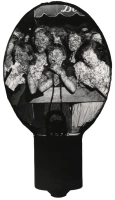Unidentified Photographer, [Postmortem Unidentified Woman], ca. 1865 (2008.81.72)
Unidentified Photographer, [Postmortem Unidentified Triplets], ca. 1875 (2008.81.51)
Unidentified Photographer, [Postmortem Unidentified Girl], ca. 1940 (879.1990)
Bill Wood, [Postmortem child], 1950s (printed 2008) (2010.14.28)
Bill Wood, [Postmortem woman], 1950s (printed 2008) (2010.14.154)
As Roland Barthes asserted, photography is “death in the future.” There are many similarities between death and photography, especially dealing with photographs of dead people. A corpse is no longer the person, but an index to which it refers, a visual manifestation of what has been, an image. Photography is also an index, a mark that shows that something has been, but is now no longer in existence. It’s the physical presence of something absent.
Postmortem photography reached its peak in popularity during the nineteenth century. At that time, death was part of everyday life and often taking a picture was the only way to remember a deceased love or newborn, especially since the infant mortality rate was very high. There were different typologies of postmortem portraits: those in which the corpse was gently lying in bed as if he/she were sleeping or portrayed in his/her coffin; those where the corpse was put together with his/her family in order to take a delusive family portrait, or finally those where the body was placed in positions that seemed alive, engaging in small daily activities, such as sitting on a chair.
When a child died, the photographer was called at home or the little corpse brought into the studio. Then every possible effort was made to make it appear that the child was asleep in bed or on a couch, or even still alive. Often the bedroom was clean and tidy, perhaps fresh flowers were added on the nightstand or the body covered with a valuable blanket. We might think of this as morbid today, but these activities were done with much love and respect for the deceased. And for the people who remained, capturing a last memory in a photograph was a way of dealing with their pain.
Nowadays traditions have changed but the function of photography remains the same: to relieve the pain of loss and prevent us from forgetting. A study conducted by researchers at the Department of Psychology at UCLA shows that the photographs of our loved ones are not only an effective talismans or tender mementos, but they can serve as substitutes for a physical presence. In other words: holding a photograph of someone who has died or is far away has almost the same beneficial effect as really holding his/her hand. The researchers concluded that having a way to access the mere memory of someone who has been lost may be sufficient to produce a feeling of emotional support. The photograph becomes a physical impression of the missing person
Alessandro Teoldi, ICP-Bard MFA 2013







This reminds me of the movie “The Others”.